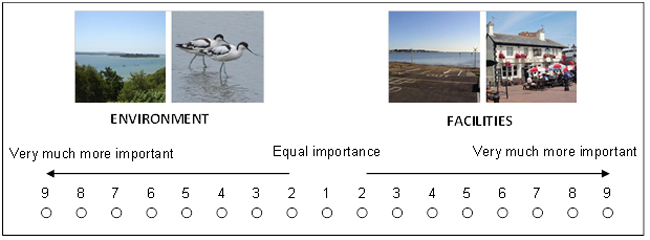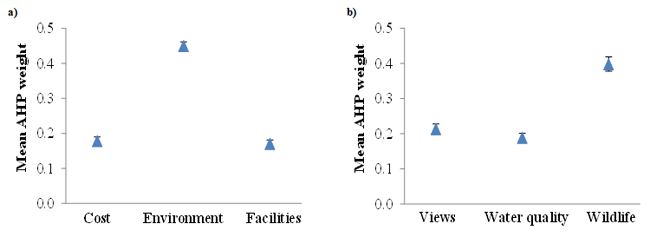3.4.2 Multi-criteria analysis

Multi-criteria analysis techniques are often used to support decision making as they provide a formal framework in which different characteristics or options can be compared and relative preferences for them ex-pressed, typically using weighting, ranking or scoring methods.
The Analytic Hierarchy Process (AHP) is an example of a multi-criteria analysis (MCA) methodology. In an Analytic Hierarchy Process assessment, survey re-spondents are asked to compare different attributes two at a time, expressing on a scale of 1 to 9 how much they prefer one attribute over the other. The Analytic Hierarchy Process method was chosen in this study because:
- it is very commonly used in environmental science for assessing the preferences of multiple individuals, and
- the pairwise comparisons used can generate more accurate relative weights than other ranking or rating methods.
In Poole Harbour ![]() , the Analytic Hierarchy Process assessment was used in a two-step process.
, the Analytic Hierarchy Process assessment was used in a two-step process.
Firstly, respondents were asked to express the relative importance to them of:
- the environment (described to them as the underlying features that shape Poole Harbour as well as other elements of the natural environment),
- facilities (the availability of built infrastructure such as car parks, slipways, shops),and
- cost factors (how much it costs to use the infrastructure and facilities),
An example of an Analytic Hierarchy Process comparison as presented to respondents is shown the following figure. The process was then repeated for three specific environmental attributes: views of the coastline, wildlife, and water quality.
 Figure: An example of an Analytic Hierarchy Process comparison
Figure: An example of an Analytic Hierarchy Process comparison
The results demonstrated that equal preference was given to cost factors and the facilities available, but importance of the environment was significantly higher. Within the environmental characteristics, wildlife was most important,and there was a small, but significant, preference for views over water quality. This finding was not driven solely by the inclusion of birdwatchers, as the relative rankings were unchanged when watersports users only were considered.

Figure: Geometric mean and 95% confidence interval for the AHP weights of all respondents (n=528) for a) the characteristics of Poole Harbour and b) different environmental characteristics

